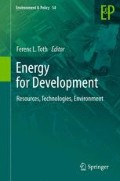Abstract
Energy resources are abundant. Their actual future availability in the market depends on a variety of constraints: production shifting to smaller deposits in increasingly harsh environments; rising exploration, production and marketing costs; excessive environmental burdens; diminishing energy ratios; and ever more stringent environmental policy and regulation. Energy demand, high prices and associated investments, innovation and technology change tend to increase flow rates to the market. Geological or other natural constraints will not impede the availability of energy resources for socioeconomic development. Mobilising resources might be hampered by inertia, long decision and investment cycles, as well as market uncertainties stemming from both the supply and demand sides. Forward-looking and stable policies are required to avoid abrupt supply and price fluctuations, and to mobilise the necessary investments for a socially optimal, long-term pathway for using energy resources that will foster sustainable development.
Access this chapter
Tax calculation will be finalised at checkout
Purchases are for personal use only
References
Adelman, M. A. (1992, June 23–24). The international energy outlook. Presented at International Energy Workshop, Harvard University, Boston.
Ahlbrandt, T., & Klett, T. (2005). Comparison of methods used to estimate conventional undiscovered petroleum resources: World examples. Natural Resources Research, 14(3), 187–210.
ASPO (Association for the Study of Peak Oil). (2011). www.peakoil.net
Bradley, R. L. (2004). Are we running out of oil? PERC Reports 22(3). Bozeman: Property and Environment Research Center. www.perc.org/pdf/sept04.pdf. Accessed 5 Sept 2011.
Brew-Hammond, A. (2012). Energy: The missing Millennium Development Goal. In F. L. Toth (Ed.), Energy for development: Resources, technologies, environment (pp. 35–43). Dordrecht: Springer.
CERA (Cambridge Energy Research Associates). (2006). In P. Jackson (Ed.), Why the “Peak Oil” theory falls down: Myths, legends, and the future of oil resources. Cambridge: CERA.
DOE (Department of Energy). (2010). Enhanced oil recovery/CO 2 injection. DOE Oil Recovery R&D Program. http://fossil.energy.gov/programs/oilgas/eor/. Accessed 28 Dec 2010.
EPI (Earth Policy Institute). (2007). Is world oil production peaking? www.earth-policy.org/Updates/2007/Update67_printable.htm
EWG (Energy Watch Group). (2007). Crude oil: The supply outlook report to the energy watch group (EWG-Series No. 3/2007). Ottobrunn: Ludwig-Bölkow-Systemtechnik GmbH.
Farrell, A. E. (2008). Energy notes. News from the University of California Energy Institute, 6, 3.
Luna, N., & Gomelsky, R. (2012). Development, infrastructure and energy: Exploring the linkages in Latin America. In F. L. Toth (Ed.), Energy for development: Resources, technologies, environment (pp. 95–112). Dordrecht: Springer.
McKelvey, V. E. (1967). Mineral resource estimates and public policy. American Scientist, 60, 32–40.
McKenzie-Brown, P. (2008). Colin Campbell and the cracks of doom. http://languageinstinct.blogspot.com/2008/03/colin-campbell-and-crack-of-doom.html. Accessed 17 Jan 2009.
NPC (National Petroleum Council). (2007). Hard truths: Facing the hard truths about energy. Washington, DC: NPC.
Odell, P. (2004). Why carbon fuels will dominate the 21st century’s global energy economy. Brentwood: Multi-Science Publishing.
Pachauri, S. (2012). Demography, urbanisation and energy demand. In F. L. Toth (Ed.), Energy for development: Resources, technologies, environment (pp. 81–94). Dordrecht: Springer.
Rogner, H.-H., Aguilera, R. F., Archer, C. L., Bhattarcharya, S. C., Dusseault, M. B., et al. (forthcoming). Energy resources and potentials. In Global energy assessment: Towards a sustainable future. Laxenburg/Cambridge: IIASA/Cambridge University Press.
UNECE (United Nations Economic Commission for Europe). (1997). United Nations international framework classification for reserves/resources: Solid fuels and mineral commodities. Geneva: ECE.
UNECE (United Nations Economic Commission for Europe). (2010). United Nations international framework classification for fossil energy and mineral reserves and resources 2009 (ECE Energy Series No. 39. Geneva: ECE. http://live.unece.org/fileadmin/DAM/energy/se/pdfs/UNFC/unfc2009/UNFC2009_ES39_e.pdf. Accessed 5 Sept 2011.
USGS (US Geological Survey). (1980). Principles of a resource/reserve classification for minerals (US Geological Survey Circular 831).
Zimmerman, E. W. (1933). World resources and industries: A functional appraisal of the availability of agricultural and industrial resources. New York: Harper & Brothers.
Zimmerman, E. W. (1951). World resources and industries. New York: Harper & Brothers.
Author information
Authors and Affiliations
Corresponding author
Editor information
Editors and Affiliations
Rights and permissions
Copyright information
© 2012 International Atomic Energy Agency 2012
About this chapter
Cite this chapter
Rogner, HH. (2012). Energy Resources. In: Toth, F. (eds) Energy for Development. Environment & Policy, vol 54. Springer, Dordrecht. https://doi.org/10.1007/978-94-007-4162-1_12
Download citation
DOI: https://doi.org/10.1007/978-94-007-4162-1_12
Published:
Publisher Name: Springer, Dordrecht
Print ISBN: 978-94-007-4161-4
Online ISBN: 978-94-007-4162-1
eBook Packages: Earth and Environmental ScienceEarth and Environmental Science (R0)

